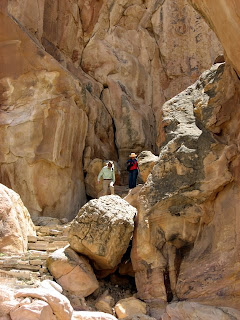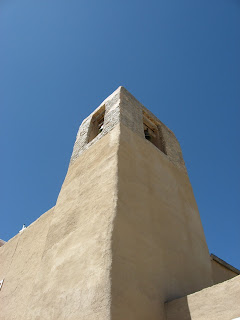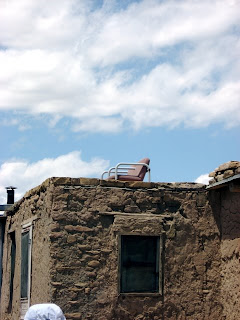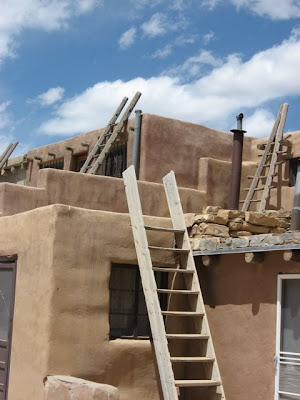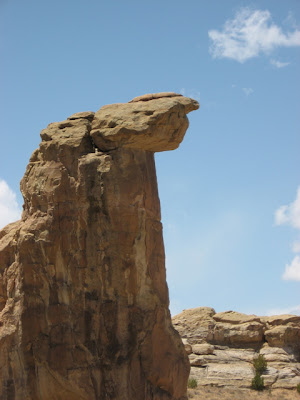 Photo courtesy of Yahoo! Movies
Photo courtesy of Yahoo! MoviesI went to see the new Sex and the City movie in Santa Fe last night. I usually try to avoid going to big new releases on opening day because I like to avoid crowds, get my choice of seats, etc. But I really felt like going to the movies and there wasn't anything else I wanted to see as much, so off I went to the Regal Santa Fe Stadium 14, a lovely year-old theatre with all those great new amenities like stadium seating and really comfy cushions on the chairs. Regal was showing the movie on four screens so I figured there was a pretty good chance there'd be a space for me!
I got there early enough to get my preferred seat--one of the seats in the front row of the second section--the ones that are designed with spaces in between groups of seats for wheelchair patrons. I love those seats because you can stretch your legs out, there's no one in front of you (except when you're trying to read the credits at the end of the movie--which I ALWAYS stay for), and I think it provides the best view of the screen....
Anyway, I have to say I think this movie is going to do huge box office. I know that the reviews have been only OK (reviewers B-, patrons B according to Yahoo Entertainment) but it's really all about the experience. The theatre was full of women (and I would say that they were mostly over-40 women) with a few brave men (though more than I would have expected). When the opening music for the TV-show started at the beginning, the audience broke into spontaneous applause. When Samantha lambasted a man who interrupted her toast at an event in Carrie's honor, the audience burst into applause again. I love that kind of spontaneity and interaction at the movies! The crowd was warm, and sympathetic, and appreciative--laughing and clapping at all the right places, and being quiet (with just a touch of non-audible cry-emotion) at the places that demanded it. No snickering junior-high students laughing at all the wrong places and hooting at the frank girl-talk.
So what that it's like five episodes of the TV show strung back-to-back? Not being an HBO subscriber, I first watched Sex and the City on Netflix DVDs in back-to-back viewing sessions--six seasons in six weeks--when recovering from surgery three years ago. So it's just like old times for me!
Wesley Morris, Boston Globe reviewer, gets it: "It's like going to somebody else's house to binge on a stack of new episodes surrounded by a bunch of girlfriends you don't know. . . . The movie is just like a half-season of the series - a funny, sappy, clumsy, crude, rambunctious, argumentative, gleefully vulgar attempt to balance the fantasy of romance with the reality that the fantasy is impossible."
Jessica Reaves, Chicago Tribune reviewer, gets it too: "Social critics are wringing their hands on the sidelines, fretting. They can't understand why so many women are so captivated by the SATC world, which is, after all, a totally fantastical place in which women have financial autonomy and healthy sex drives. It's a materialistic, completely unrealistic world, the scolds tell us. Yes, of course it is. That's kind of the point. It's escapist fun. But it's also a show (and now a movie) with an enormous amount of heart, the kind of viewing that reminds you to call your best friend, just so she knows you're there if she needs you."
Manohla Dargis at the New York Times doesn't: "I wish Ms. Parker had let that bee in her bonnet go silent, because the movie that she and Mr. King have come up with is the pits. . . . vulgar, shrill, deeply shallow — and, at 2 hours and 22 turgid minutes, overlong."
And Lou Lumenick at the New York Post complains that "the men serve strictly as plot devices." Hellloooo!!! What about every other summer movie made in the past ten years that was aimed at an audience of 14-year-old boys??? It's a trip and a treat to see a blockbuster-in-making that's aimed at an over-40 female audience!!! And it's clear to me, based on the response of the decidedly non-Manhattan audience here in Santa Fe, that its appeal to its target audience is universal.


